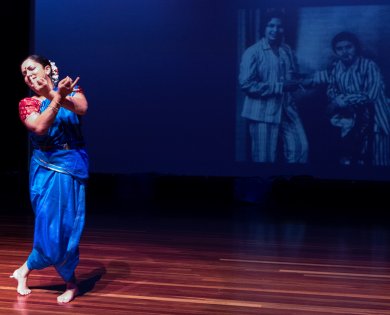
|   |

|   |
Becoming M.S. Subbulakshmi: A bold move in revealing our true history - Nithya Iyer e-mail: msnithyaiyer@gmail.com Photo: Arun Munoz Photography, Melbourne June 27, 2016 On a wintry Saturday night in Melbourne the regulars of the Melbourne Carnatic music scene gathered to celebrate the illustrious career of Carnatic vocalist M.S. Subbulakshmi with talented local exponents of classical vocal, violin and veena. Including performances from a range of professional and emerging artists the event saw the regular turnout of Australian South Indians keen to immerse themselves in the arts from their home and childhood. But amidst the silk saris and traditional Carnatic songs there was a new addition, and an unexpected one at that. After a 20 year international journey from professional South Asian dancer of Bharatam Dance Company fame (founded by Dr. Chandrabhanu) to academic, performer, choreographer, professor and author, Dr. Priya Srinivasan has returned to the Melbourne stage to celebrate and challenge the status quo of classical South Asian arts with her latest work Becoming M.S. Subbulakshmi. Part storytelling, part dance, and part video projection, Becoming M.S. Subbulakshmi is a multidisciplinary work that bridges archival research, narrative storytelling, Bharatanatyam and importantly, socio-political commentary.  Commencing with the sound of the sruti, a short photo-documentary commences, painting an endearing portrait of the young M.S.S. through pivotal points in her youth, marriage and early career. The audience is hushed, many of them deeply connected with the music and persona of the Tamilian songstress. As the projections slows, the lights dim, and the voice of M.S.S. rises from the speakers. A spotlight upon the stage illuminates a figure clad in a blue silk sari to the audience. Sitting cross-legged, her hand rises encircling the air and her body sways as the raga alapana ladders to greater and greater magnitude; the intoxication one only knows from witnessing the blissful expression of a Carnatic singer deep in melody. From this place of intimate embodiment, Srinivasan gently guides us through the story of M.S.S. in first person. Crafted with the gestural finesse of Bharatanatyam and interspersed with questions, and generous and fluent helpings of Tamil colloquialisms, the audience is taken on a visual, kinesthetic, and auditory time warp. Srinivasan charts the early life of the songstress, and tells us of her struggles, her victories and her connection to the divine. But importantly, she tells us of the tribulations experienced by M.S.S. in growing up as a child of a Devadasi, a single mother, in a world dominated by Brahmin men - a side of this story that is rarely told. The work thus illustrates the life of M.S.S. in a way that has been hidden to most people. Against the backdrop of a black and white photograph of M.S.S. smoking a cigarette in her pyjamas, we are told the stories of her rebellious streak, her adventurous spirit, and of her stubborn desire to live the life that she pleased regardless of the limiting social norms of the time. In this way, Becoming M.S. Subbulakshmi baptizes M.S.S. into her rightful place as a feminist pioneer and socio-political trailblazer. It seeks to shift the context and understanding of M.S.S. in history by illuminating not only her personified characteristics, but also by directly acknowledging the social limitations and prejudices that she faced growing up in India, many of which persist in contemporary India and in diasporic communities today. Becoming M.S. Subbulakshmi is part of a larger exploration into performed storytelling by Srinivasan, who is back on the scene in Melbourne to empower emerging artists of a new generation. But importantly, a work such as this also evoked deep and poignant responses from the older generations of South Asians in the audience, men and women alike, who had grown up alongside the radios and film screens full of M.S.S as they endured the experiences of their generation. Srinivasan notes that it is her aim to bring the invisible stories of poor women to the light using a medium that combines performance, research, and the body. This quality is clear in her work and an exciting space to perceive. Becoming M.S. Subbulakshmi is a welcome dose of performative boldness, creative finesse and innovation in bringing new life to a South Asian history that remains to be told in its fullness. I dare say, watch this space. Nithya Iyer is a Melbourne based writer and performing artist engaged in the exploration of classical, contemporary, and cross-disciplinary performing arts and culture. She is the Chair of the Jambudvipa Association for Indian Arts, established by Dr. Chandrabhanu, with whom she has trained in Bharatanatyam since 2006. Nithya is the founder of cross-disciplinary practice BON. |